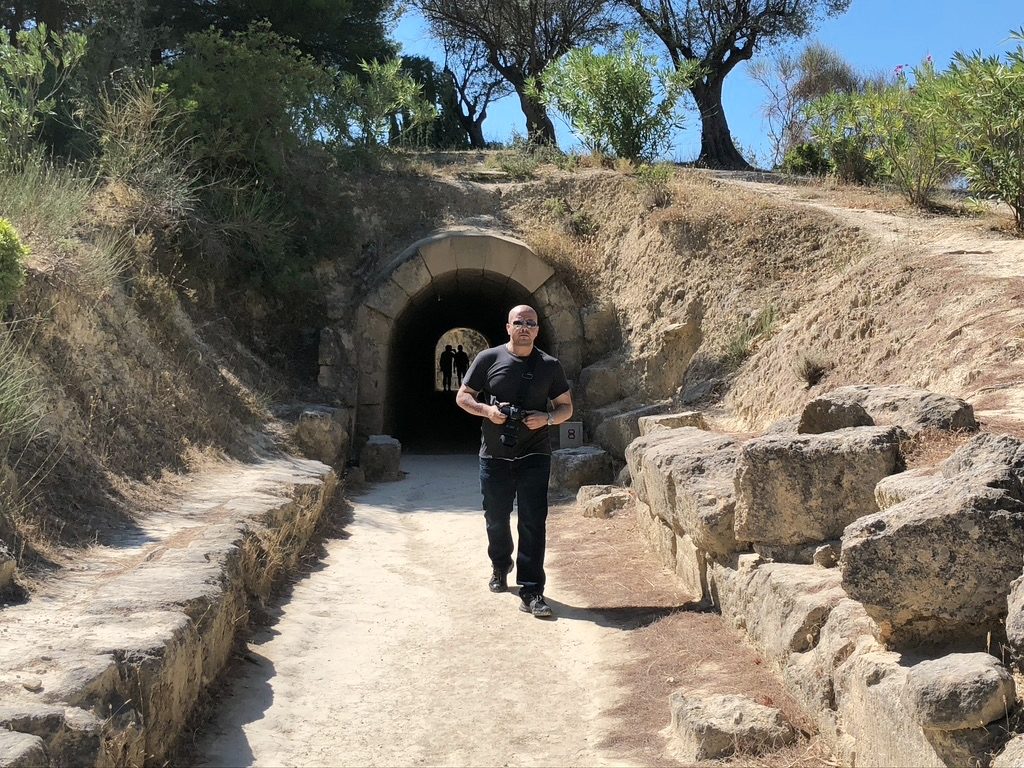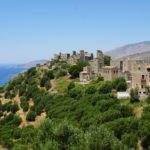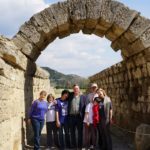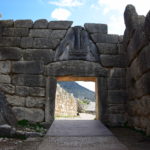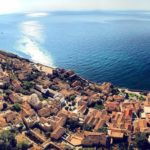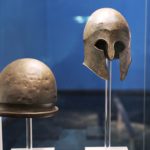5 Days
Private Tour
English
UP TO 12 GUESTS
5 Days Private Tour: Olympia-Mani-Sparta & Argolida
Got a Question?
Contact UsHighlights
Mani private tour
Day 1st:
- Corinth Canal
- Ancient Olympia
- Archaeological Museum Olympia
Overnight: Olympia
Day 2nd:
- Messene Archaeological Site – Messene Museum
- Kalamata – Kardamili – Areopoli
- Cave Glyfada (Dirou Cave)
Overnight: Mani
Day 3rd:
- Archaeological Site Mystras
- Village of Mystras
- Sparta
- Ancient Sparta – Archaeological Sparta Museum
- Museum of The Olive
Overnight: Sparta
Day 4th:
- Mycenae
- The picturesque town of Nafplio
- Palamidi Castle – Bourtzi
Overnight: Nafplio
Day 5th:
- Epidaurus
- Ancient Corinth – Temple of Apollo
Itinerary
1st Day:
This tour addresses visitors who wish to visit southern Greece and Peloponnese peninsula for the most renowned sites of the territory but also for visiting a not so famous but still of rare beauty location, the region of Mani. The tour starts with a drive along the coast. On the way you will view of some Greek seaside villages and the island of Salamis (where the historical naval battle took place between the Athenians and the Persians) . Our first stop the Corinth Canal. Opened in 1892 separating the Peloponnese peninsula from the rest of Greece and connecting the Saronic Gulf to the Corinthian Sea. You will have time to walk across on a pedestrian bridge to admire the canal closer, (if you’re game,) on some days bungee jumping is an option.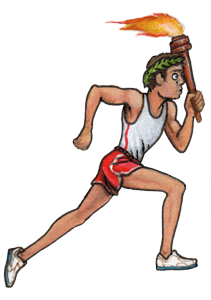
After this small stop, we will drive to Ancient Olympia following the main highway constructed within the mountains of Peloponnese and as we continue we will reach rural roads between small Greek villages to finally find the western coast facing the Ionian Sea. After a scenic route, we will reach the small village of Ancient Olympia, going passed the river Alfeios, located exactly at the sacred land that gave birth to the Olympic Games, the village is offered for a relaxing walk and of course for a traditional Greek meal. After settling at the hotel we will head towards visiting the site and the museum of Ancient Olympia. You will have the privilege of coming across one of the largest sites in Greece, the birthplace of the Olympic Games the Sanctuary of Olympian Zeus. Walking in the site you will pass by the Gymnasium, the Palaestra, the workshop of Phidias, the Temple of Zeus and you will end up at the Stadium where every four years the Greeks competed for glory and spiritual elevation, honoring their cities. The museum is also unique as it includes the renowned statue “Hermes of Praxiteles” with its perfect analogies and tools that belonged to Phidias himself. With these tools, he managed to create one of the Seven Wonders of the World “the gold ivory statue of Zeus”. Then you can rest in your hotel.
2nd Day:
Having spent the night at Olympia the next morning we will depart for Areopoli driving by the Ionia Sea southwards we will make a stop at Ancient Messini to visit the site and the archaeological museum. Ancient Messini is the best-preserved ancient Greek city, visiting the huge site you will walk within the streets of the city by the ancient theater. After the site, our next stop will be Kalamata (where Kalamata Olives are produced) a beautiful Greek city by the sea where we will have our lunch. Continuing even further south we will pass by the villages of Kardamili and Stoupa following the western coast of the Mani peninsula, our destination will be Areopoli where we will spend the rest of the day and our night. Areopoli is a village of the Mani territory that was never conquered by the Turks and still has the traditional old Greek look. Even today everything is made in the traditional mainland Greek color of light brown.
3rd Day:
In the morning we will depart from Areopoli to drive around the peninsula of Mani, the small villages and the beautiful beaches are unique carrying a proud part of Greek history. Mani played a very important role in the war of independence remaining free it helped the rest of Greece be liberated. After driving around Mani we will stop at Gytheio, a small town by the sea very close to Sparta, Gytheio was the ancient port of Sparta. This is where we will stop for you to have lunch then continuing we will drive until Sparta to spend the night.
4th Day:
On the next day, we will reach the village of Mystras located very close to Sparta once you see Mystras you will automatically understand why this location stands so unique within the Greek sites. Known as the ghost city, fortified on a citadel, Mystras is one of the two locations in Greece that preserves not only medieval churches but also ordinary houses, mansions and palaces of the Byzantine Empire in combination with Frankish elements. Walking in the site on the upper point you will reach the citadel and enjoy a magnificent view of the surrounding areas while walking downhill you will meet the palaces and the Royal courtyards. Although known as the ghost city most of the monasteries are still in use and the monks will gladly show you around their small society. Before you exit you will come across the chapel of St. Demetrios, on its floor survives a plaque depicting a two head eagle (the symbol of Byzantium). It was on this very plaque that Konstantine Palaiologos kneeled before he was crowned the last emperor of the Byzantium. Before visiting Sparta we will stop at a traditional Greek tavern at the small village of Mystras. Following that, we will spend the rest of our time in Sparta known as the eternal rival city of the Athenian Democracy. Sparta revolved around a different Cosmo theory for the ancient Greek standards. Initially known as the birth place of Helen of Troy and the Kingdom of Menelaus (in the Mycenaean period), Sparta was organized as a purely military society in the ancient Greek period. It was the city of the two Kings were a few aristocrats ruled and of course the city where Leonidas and his 300 Spartans marched from to face the Persian army in Thermopolis in 480BC. The city whose one soldier counted as ten soldiers from any other Greek city. Reaching Sparta we will visit the ancient citadel of Sparta where you will have a view of the ancient theater being revealed gradually in front of your eyes. Continuing we will pass in front of the stadium where the statue of King Leonidas stands marking the ending point of Spartathlon race (Athens – Sparta 245,3 km). Then we will drive to Nafplio to spend the night.
5th Day:
The following day we will drive up to the castle of Acronafplia for a panoramic view of Nafplio, our next destination is Epidaurus, After a short drive you will be able to visit one of the most 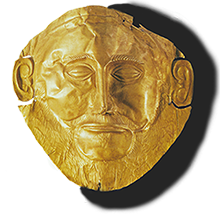 important ancient Greek sanctuaries dedicated to God Asclepius, the God of healing and medicine, located in peaceful environment spread on a hilly area reaching its highest point which is the theater of Epidaurus. The best-preserved ancient Greek theater dated 4th-century BCΕ, proof of what miracles the ancient Greek minds could create. Υou can test the acoustics great even today and climb up until the upper seats just to close your eyes and dream you attended an ancient Greek tragedy. After the Epidaurus Theater, we will visit the site of Mycenae dated to the 2nd millennium BCE representing the era of Achilles, Agamemnon, and Helen of Troy. In the site, you will see the renowned Lions Gate (the oldest architectural sculpture in Europe), the cyclopean walls, the burial circle A and the remains of Agamemnon’s Palace. Within the site, there is a modern museum exhibiting the findings of the “City of Gold” before leaving the site we will make a small stop at the treasury of Atreus, the best-preserved Tholos tomb, one of the finest examples of the Mycenaean architecture.
important ancient Greek sanctuaries dedicated to God Asclepius, the God of healing and medicine, located in peaceful environment spread on a hilly area reaching its highest point which is the theater of Epidaurus. The best-preserved ancient Greek theater dated 4th-century BCΕ, proof of what miracles the ancient Greek minds could create. Υou can test the acoustics great even today and climb up until the upper seats just to close your eyes and dream you attended an ancient Greek tragedy. After the Epidaurus Theater, we will visit the site of Mycenae dated to the 2nd millennium BCE representing the era of Achilles, Agamemnon, and Helen of Troy. In the site, you will see the renowned Lions Gate (the oldest architectural sculpture in Europe), the cyclopean walls, the burial circle A and the remains of Agamemnon’s Palace. Within the site, there is a modern museum exhibiting the findings of the “City of Gold” before leaving the site we will make a small stop at the treasury of Atreus, the best-preserved Tholos tomb, one of the finest examples of the Mycenaean architecture.
The last stop will be the site of Ancient Corinth. The city dominated by the hill of Acrocorinth and the old Castle, the oldest and largest castle in southern Greece. It is located at the foot of the hill includes the Roman Agora of Corinth, the temple of God Apollo and a small museum. Apart from its archaeological and historical interest Ancient Corinth is also one of the most popular religious destinations in Greece as this was where the Apostle Paul preached Christianity, was judged by the tribunal in the Agora and established the best organized Christian church of that period. Lastly on the way back will follow the western coast of Saronic Gulf to reach Athens again.
Inclusions - Exclusions
Private Tours are personal and flexible just for you and your party.
Inclusions:
- Professional Drivers with Deep knowledge of history. [Not licensed to accompany you in any site.]
- Accommodation with breakfast (According to your booking)
- Hotel pickup and drop-off
- Guaranteed to skip the long lines / Tickets are NOT included.
- Fuel surcharge
- Local taxes
- Bottled water
Exclusions:
- Licensed Tour guide on request (Additional cost )
- Accommodation with breakfast (According to your booking)
- Entrance Fees
- Personal expenses (drinks, meals, etc.)
- Airport Pick Up and drop-off (Additional cost)
Entrance Fees
ADMISSION FEES FOR SITES:
Summer Period: 121€ per person
(1 April – 31 October)
Ancient Olympia: 20€ (08:00- 20:00)
Messene: 10€ (08:00- 20:00)
Mystras: 20€ (08:00- 20:00)
Ancient Sparta: 10€ (10:00- 18:00, Tuesdays closed)
Museum Olive and Olive Oil: 6€ (10:00- 18:00, Tuesdays closed )
Mycenae: 20€ (08:00- 20:00)
Epidaurus: 20€ (08:00- 20:00)
Ancient Corinth: 15€ (08:00- 20:00)
Winter Period: 74€ per person
(1 November – 31 March)
Ancient Olympia: 10€ (08:00- 15:00)
Messene: 10€ (08:00- 15:30)
Mystras: 10€ (08:00- 15:30)
Ancient Sparta: 10€ (10:00- 15:00, Tuesdays closed)
Museum Olive and Olive Oil: 6€ (10:00- 17:00, Tuesdays closed)
Mycenae: 10€ (08:00- 15:30)
Epidaurus: 10€ (08:00- 15:30)
Ancient Corinth: 8€ (08:00- 15:30)
Free admission days:
- 6 March (in memory of Melina Mercouri)
- 18 April (International Monuments Day)
- 18 May (International Museums Day)
- The last weekend of September annually (European Heritage Days)
- Every first Sunday from November 1st to March 3rd
- 28 October
Holidays:
- 1 January: closed
- 25 March: closed
- 1 May: closed
- Easter Sunday: closed
- 25 December: closed
- 26 December: closed
Free admission for:
- Escorting teachers during the visits of schools and institutions of Primary, Secondary and Tertiary education and of military schools.
- Members of Societies and Associations of Friends of Museums and Archaeological Sites throughout Greece with the demonstration of certified membership card
- Members of the ICOM-ICOMOS
- Persons possessing a free admission card
- The employees of the Hellenic Ministry of Culture and Sports and the Archaeological Receipts Fund, upon presentation of their service ID card.
- The official guests of the Greek government, with the approval of the General Director of Antiquities.
- Young people, under the age of 18, after demonstrating the Identity Card or passport to confirm the age.
Reduced admission for:
- Greek citizens and citizens of other Member – States of the European Union who are over 65 years old, upon presentation of their ID card or passport for verification of their age and country of origin.
- Holders of a solidarity card
- Holders of a valid unemployment card.
- Large families’ parents of children up to 23 yrs old, or up to 25 yrs old (on military service/studying), or child with disabilities regardless the age, having a certified pass of large families, certification from the Large Family Association or a family status certificate issued by the Municipality
- Persons with disabilities (67 % or over) and one escort, upon presentation of the certification of disability issued by the Ministry of Health or a medical certification from a public hospital, where the disability and the percentage of disability are clearly stated.
- Single-parent families with minors, upon presentation of a family status certificate issued by the Municipality. In the case of divorced parents, only the parent holding custody of the children
- The police officers of the Department of Antiquity Smuggling of the Directorate of Security
- Tourist guides upon presentation of their professional ID card.
- University students and students at Technological Educational Institutes or equivalent schools from countries outside the EU by showing their student ID.
History
Corinth Canal:
The famous Corinth Canal connects the Gulf of Corinth with the Saronic Gulf in the Aegean Sea. It cuts through the narrow Isthmus of Corinth and separates the Peloponnesian peninsula from the Greek mainland, thus effectively making the former an island. The canal is 6.4 kilometers in length and only 21.3 meters wide at its base. Earth cliffs flanking either side of the canal reach a maximum height of 63 meters. Aside from a few modest-sized cruise ships, the Corinth Canal is unserviceable to most modern ships. The Corinth Canal, though only completed in the late 19th 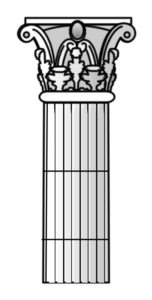 century, was an idea and dream that dates back over 2000 thousand years.
century, was an idea and dream that dates back over 2000 thousand years.
Before it was built, ships sailing between the Aegean and Adriatic had to circumnavigate the Peloponnese adding about 185 nautical miles to their journey. The first to decide to dig the Corinth Canal was Periander, the tyrant of Corinth (602 BCE). Such a giant project was above the technical capabilities of ancient times so Periander carried out another great project, the diolkós, a stone road, on which the ships were transferred on wheeled platforms from one sea to the other. Dimitrios Poliorkitis, king of Macedon (c. 300 BCE), was the second who tried, but his engineers insisted that if the seas where connected, the more northerly Adriatic, mistakenly thought to be higher, would flood the more southern Aegean. At the time, it was also thought that Poseidon, the god of the sea, opposed joining the Aegean and the Adriatic. The same fear also stopped Julius Caesar and Emperors Hadrian and Caligula. The most serious try was that of Emperor Nero (67 CE). He had 6,000 slaves for the job. He started the work himself, digging with a golden hoe, while music was played. However, he was killed before the work could be completed.
In the modern era, the first who thought seriously to carry out the project was Kapodistrias (c. 1830), the first governor of Greece after the liberation from the Ottoman Turks. But the budget, estimated at 40 million French francs, was too much for the Greek state. Finally, in 1869, the Parliament authorized the Government to grant a private company (Austrian General Etiene Tyrr) the privilege to construct the Canal of Corinth. Work began on Mar 29, 1882, but Tyrr’s capital of 30 million francs proved to be insufficient. The work was restarted in 1890, by a new Greek company (Andreas Syggros), with a capital of 5 million francs. The job was finally completed and regular use of the Canal started on Oct 28, 1893. Due to the canal’s narrowness, navigational problems and periodic closures to repair landslips from its steep walls, it failed to attract the level of traffic anticipated by its operators. It is now used mainly for tourist traffic. The bridge above is perfect for bungee jumping.
Ancient Olympia:
The history of Olympia is strongly connected to the Olympic Games. Historical records indicate that the games began in 776 BCE as a local festival to honor god Zeus. However, along the centuries, these games gained more and more popularity and all city-states of Greece would send their finest men to participate in the games. This event was so important for the ancient world that even all warfare would stop for a month so that the towns would send their best youths to participate in the games. This athletic festival occurred every four years and lasted for five days, including wrestling, chariot and horse racing, the pentathlon (discus throwing, javelin throwing, long jump, running and pancratium).
However, the athletes would stay for 1 or 2 months before the games in Olympia to train in the Palaestra. Before the games, the high priestess of Olympia marked the beginning of the games lighting the Olympic flame. Also, offerings and ceremonies in the temple of Zeus and the temple of Hera were practiced to ask for the favor of the gods. The games would take place in the stadium and people would watch them from the hills around it. All athletes were male and would take part in the games in total nudity. Women were forbidden under the penalty of death to part take in the games or even watch them as a spectator. The only woman who could watch the games, and in fact from a privileged spot, was the priestess of the temple of Demeter in Olympia.
There were no seats for the spectators and all people regardless of their social state would sit on the ground. The Hellanodikae, a body of priests, were responsible to name the winners. The reward of the winning athletes was a crown made from a wild olive tree, which was enough to honor him, his family and his city for decades. In fact, it was such an honor to be an Olympic winner that their town even pulled down a part of their city walls, as the town would be protected by the winner. At the same time, the political personalities from different parts of Greece took advantage of the games to make speeches and try to resolve differences against each other. The games were also a good opportunity for traders to make business deals. Unfortunately, in 393 AD, the Olympic Games were suspended by the Byzantine Emperor Theodosius, as it was considered a pagan custom. It was the time when Christianity was the dominant religion of the Byzantine Empire and everything connected to the ancient Greek spirit was considered pagan. Thus the games were stopped, the temples of Olympia were turned into churches and important statues, among which the golden statue of Zeus, a miracle of the ancient world, was transferred to Constantinople.
The revival of the Olympic Games in the modern era was an idea of the French Baron Pierre de Coubertin, who founded the International Olympic Committee in 1894 and only two years later, in 1896, the first modern Olympic Games took place in Athens, at the renovated Panathenaic Stadium. Since then, the games take place every 4 years in a different place in the world every time.
Messene:
Before this city was built there was a very small village on the site, called Ithomi, named after the mountain it’s was built on. At this time there was an acropolis on the mountain top, where an old church now stands. But the inhabitants were driven out or enslaved after the Spartan invasion. Messene was founded in 740 BCE by the Theban general Epaminondas when he freed the area of Spartan rule. It is one of the rare sites that were never completely destroyed or built over. Messene was a real city it has sanctuaries, public buildings, tombs, houses and fortifications. The city was very well planned all the buildings had the same direction, east to west and all the roads were north to south, making up an urban grid known as the Hippodameion System.
EXCAVATIONS
The first small excavation began in 1831 by a French group. The Greek Archaeological Society began excavations of the public buildings in 1895 under Themistocles Sofoulis. Then George Economou was in charge of the digs in 1909 and in 1925. But it wasn’t till 1957 under Anastasios Orlandos, that excavations were done on a regular basis, (every summer). In 1986 the Society put Professor of Archaeology Petros Themelis in charge. Altogether they have made some incredible finds bringing to life the buildings that Pausanias saw and described when he visited the city in (155-160 AD)
FORTIFICATION
The circular wall surrounding Messene is 9 km long and 7 to 9 m high. It is made entirely of stone and was regularly reinforced. The stone is bulging and rough, not a straight cut, flat surface to show strength. It had 30 two-story squared and rounded guard towers, barracks and two monumental gates, the Arcadian Gate and the Laconian Gate. The best-preserved part is on both sides of the Arcadian Gate, this gate is so wide that even trucks can pass through. On the floor of the gate, there is a small mosaic pig. This was a symbol of Dimitra, of fertility, of life; it was put here by the artist to symbolize the rebirth of the area.
THEATER
The theater which dates back to the Hellenistic Period was reconstructed in the years of the Emperors Augustus Tiberius and in the mid-2nd century AD, by the wealthy Roman family named 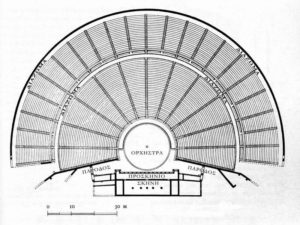 Saithidas but in Early Christian times, many parts of the theater were used to build the churches. The theater is one of the largest in the ancient world. It seated 12,000 people. It is not built against a hill as most were, so they had to build a semi-circular surrounding which had two walls with dirt in-between them to hold it up. Near the stage, there was running water, and we can still hear the water today. In the front seats, there are two thrones (originally there were six of them) for priests and important city officials. The priest would wash his hands and then go to the altar where offerings we placed before the play started. The stage was the first with mobile scenes which were pulled on wheels on the grooves in carved on the floor. There was also a skinothiki with a platform. The stage had an opening of 40 m. and is in the Roman style while the rest is Hellenic. In Roman Times the place of the Orchestra was used for gladiator fighting.
Saithidas but in Early Christian times, many parts of the theater were used to build the churches. The theater is one of the largest in the ancient world. It seated 12,000 people. It is not built against a hill as most were, so they had to build a semi-circular surrounding which had two walls with dirt in-between them to hold it up. Near the stage, there was running water, and we can still hear the water today. In the front seats, there are two thrones (originally there were six of them) for priests and important city officials. The priest would wash his hands and then go to the altar where offerings we placed before the play started. The stage was the first with mobile scenes which were pulled on wheels on the grooves in carved on the floor. There was also a skinothiki with a platform. The stage had an opening of 40 m. and is in the Roman style while the rest is Hellenic. In Roman Times the place of the Orchestra was used for gladiator fighting.
STADIUM/GYMNASIUM
This is one of the best-preserved in all of Greece and unique because it is the only combined Stadium and Gymnasium. In ancient Greece the Gymnasium wasn’t a place you worked out, it was a school. From inscriptions, we know that it was founded in the 3rd century BCE. Inside the stadium some of the seats are white. These seats are new and put in to complete the seating. On the high left side of the seating, reading the letters on the side of the steps while coming down we read the name ‘Nikiratus’. These seats were bought from the city in the name of Tibarius Claudius Nikiratus to seat his family and friends. But we see letters on other steps too, graffiti in bold, large uneven letters. We know these are from Roman Times because Greek writing was smaller, neat and uniform in size, more discrete. These are of a more brutal time of gladiators and animal fights. In Roman times the south side of the “horseshoe» stadium was closed off to give it an oval shape cutting off the Hellenic part, turning the stadium into an arena. The stadium was surrounded by Doric halls that belonged to the gymnasium and to the west of this was the Palaestra. These 3 covered halls were in the shape of the Greek letter Pi. The northern hall was a double one so it had an inner and outer row of columns. The east and west ones were single. Many statues were found in the west hall. These can be seen in the museum. The most impressive is Herms of Messinia. He is 207cm high and a replica of the 4thcentury BCE Herms. The only difference is in the face. The artist used the face of a Messinian youth who had died. These halls were where the students worked out or had lessons in heatwaves or harsh winter. In the gymnasium, the courses were Arithmatic, Literature, Geometry, and Music. During recess, the boys played games. They played naughts and crosses and dice games, these games and names have been found carved into the stones of its propylia. There are also columns full of names. These are the school rosters; on the bottom of some lists is the word ΤΡΟΦΙΜΟΣ and a name. The Trofimos was a freed slave who cooked for and served the students. All the students were of the elite class and only free men and landowners could send their boys here.
MAUSOLEUMS
During the 2nd century AD, the city was at its peak the Saithidas family funded the reconstruction of the stadium. So the family mausoleum was put on the far south side looking into the stadium. This memorial was a four-column Doric prostyle temple. Pausanias tells us that the man they honored so much was a lifelong Messinian high priest and Elladarchis of the public of Achaia (in Roman Times). West of the western hall there is another tomb, one with the ramp, on the grounds of its entrance in the Ionic eaves are the names of the dead men and women who have been honored. Inside were 8 cist graves, two by two around a square tray. The building was square 4.66mx4.66m with a conical roof. On the roof was a Corinthian column with bronze work on it (which has been saved). This type of monument is not typical of the Hellenic Period. There is another tomb. It is a peioschimo monument. On its east side, it had friezes with a series of animals and then detached a lion eating a deer. This tomb was sealed with a stone door (like the Macedonian tombs). Inside seven cist graves were found along with funeral gifts and gold jewelry.
THE WATER SOURCE OF ARISONE
Between the theatre and the agora, a large water source was found. And Pausanias tells us that it was the Source of Arsione. Arsione was the daughter of the mythical king of Messenia Leucippus and the mother of Asclepius. The water here originated from the source Klepsidra. The source had three tanks, the longest one was 40 m long and it was in front of a retaining wall between the wall and the tank was a small portico with Ionic half-columns. A semi-circular podium right in the middle of the tank carried a group of bronze statues. The other 2 tanks were lower and placed on either side of the paved patio. The source was built in three stages. Its first building stage (late 3rd century BCE) the source was enclosed with Doric columns. These were removed in the second stage (1st century) but the final repairs and remodeling came in the years of Emperor Diocletian (284-305ΑD). The early Christians who also used the source built a watermill in the early 6th century AD.
ROMAN VILLAS
In the Roman Era, the aristocrats liked to live close to the theatres and that’s what they did in Messene. In the villas found, of the late Roman Period, beautiful mosaic floors have been found. Some have geometrical shapes, another has the name of its (renowned of the time) artist, but the most special is what we think is the house of Saithidas (4th century AD). One floor is framed with ivy leaves (which celebrate Dyonisos) with a frame of geometrical shapes and then a young Dyonisos (in eastern style dress) with the female figure of Ariadnne. There is also a smaller figure to the left, kissing the god’s hand this is the house owner.
AGORA
The ancient agora was huge, it had the temples of Messina and Ascplepius but also temples of Poseidon, Zeus, and Aphrodite as Pausanias tells us. Here we have the roman bathes with little terracotta columns. A clay floor lay over these and the bathes were heated by fire lit under the floor. This method is called a hypocaust. The Arora was full of people it was for walking, displays, and  entertainment. It had frescos and conches with statues. But it was also a business and government area; on the east edge are three marble tables which are in very good condition. These were for the merchant control. Each table had different sized cavities, one for wine one for oil and one for cereals. Traders were checked at least once a year and the punishment for shopkeepers who cheated their customers was harsh.
entertainment. It had frescos and conches with statues. But it was also a business and government area; on the east edge are three marble tables which are in very good condition. These were for the merchant control. Each table had different sized cavities, one for wine one for oil and one for cereals. Traders were checked at least once a year and the punishment for shopkeepers who cheated their customers was harsh.
ASCLEPION
Pausanias tells us that the Asclepion was a museum of statues and was not just for the sick. It had over 140 bases for bronze statues. It is a large almost square area (71.91x 66.67m) with 4 internal halls of Corinthian columns opening to the central open-air courtyard. On the east of this are 3 buildings, the first on the corner, is the small, roofed, theater like ekklisia, the propylion and the Synedrion which also has a hall of archives. The ekklistirion was a long structure with 2 entrances and a semi-circular orchestra which seated 800 people. It was also a theater but only for religious plays. It had beautiful colored mosaic tiles covering the 21m stage and the foreground had 3 openings. Standing on the stage you would have been able to see the temple of Zeus Ithamoda on the mountain top, where the old monastery now stands. But it also had a political character making the city more democratic. Today the ekklistirion is used for cultural events. On the north side of the courtyard is the temple of the Asclepius, with its large alters. The outside was 13.67×27.94m on a 3 step krepis and was 9m high. The cella, the pronaos, and the opisthodomos were made of local limestone but the colonnade was coated in sandstone. On its east side is a ramped entrance.
THE TEMPLE OF ARTEMIS
The temple of Artemis is covered because some parts of it are made of sandstone. In the center of the temple is the podium of the statue of the goddess Wise Artemis. Pausanias tells us that it was the work of Damofondas. It is interesting that in the sikos were a seiries of statues on pedestals about 10 of them. To the right is the alms chest for wishes and favors from the goddess. It had a strong stainless steel cover with 2 locks, one on each side, and a slit to put the coins in.
EARLY BYZANTINE BASILIKA
Even though there had been Christians here, in Messene, since the 3rd century AD, this Early-Byzantine Basilica wasn’t built till the late 7th-early 8th century AD when their population became stronger. There were at least 2 basilicas in the agora and at least 40 Christian tombs have been found. The whole area from the church to the theater was a cemetery. On this basilica there is an inscription read ‘the work of Isidos’ and we know from Pausanias that a temple of Isis was nearby. To make this church, material not only from the temple but from other buildings were used too, especially from the theater. Much of the theaters seating were used here. The church seems to have been reconstructed at some time, we don’t know when, but we do know that a Christian population continued here till the 15th century.
HIEROTHISION
In the Hierothision there was an ancient tripod here which Homer refers to as ‘apyroi’ which means without fire. This was a building that housed the statues of all 12 Olympian gods. But there was also a bronze statue of Epaminondas, the Theban general who freed the land from Spartas rule and founded the city. All the Statues were of equal size which shows us just how important Epaminondas was and how much they honored him.
SCULPTORS WORKSHOP
Many other buildings have been found in the city. One of these is a sculptor’s workshop. It was a large workshop because it had apprentices. In it was found a pit full of rejected body pieces. The workshop dates back to the time of Augustus, which is also the time of the replicas and portraits.
ZEUS ITHOMATA- ACROPOLIS
Continuing up the mountain, on the ancient road, there was a limestone quarry. The road has marks from the heavy carts that carried the stones. And further up where the old monastery (dedicated to the Virgin) stands was the acropolis. The whole mountain was dedicated to Zeus Ithomata, from where it gets its name. The Messenians believed that Zeus was born and brought up here. So naturally on the mountain top was the great temple of Zeus. On the side of the old monastery, built into the wall is a large base of a bronze tripod. This would have had 3 bronze legs which had lion’s feet and on top was a bronze cauldron the tripod dates back to the early stages of the temple about the 8th century BCE, way before the founding of the city.
The acropolis played a great part in the 1st Messenian-Spartan War (7th century BCE) where the Messenians lost after a heroic siege and again in the 6th century BC. In 465 BC however, an earthquake hit Sparta and the Messinian slaves found the opportunity to revolt. The revolt is the 3rd Messenian -Spartan War. After the Spartans won again they made the Messenians sign a treaty in 459 BCE. Under the terms of this treaty, the defeated Messenians would be free to go but, only if they, and their entire families, agreed to leave Peloponisos. During Frankish times, the acropolis was reconstructed into a fort, and named Castle Voulkanou and in 1358 it was given to Nerio the 1st Astagoli, Prince of Achaia.
This is a small museum that houses some of the finds of the site. It is built on land donated to the Archaeological Society of Greece by homogenous D. Lazaridis
Diros Caves:
One of the most beautiful caves in the world is located on the west coast of Laconia’s Peninsula, at Diros Bay, nature with incomparable art and patience has carved a miracle beyond imagination. Bright white stalactites and stalagmites creating a unique spectacle that takes your breath away!
The Diros Caves are actually three separate caves: Vlyhada (or Glyphada) which is the only accessible one, Alepotrypa and Katafygi. Many Paleolithic and Neolithic artifacts were found in the caves, quite a few of which are in display in the museum. This drove to the conclusion that these caves were one of the earliest inhabited places in Greece.
From around 1900, the locals knew of the caves, but nobody could have imagined the miracle was hiding inside. It was only in 1949 that John and Anna Petrochilos, founders of the Greek Speleological Society, began to explore the caves systematically. These caves began to form before hundreds of thousands of years. Understand that the stalactites and stalagmites beneath the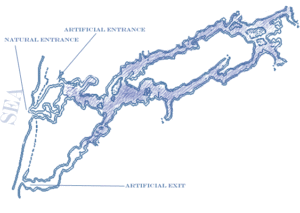 water were formed when the sea level was lower than it is now and some of them are found 71 meters underwater. Inside the cave have been found fossilized bones of lions, panthers, hyenas, ferrets, deer and the largest reservoir of hippos in Europe. The human presence is proved by the potteries found near the natural entrance.
water were formed when the sea level was lower than it is now and some of them are found 71 meters underwater. Inside the cave have been found fossilized bones of lions, panthers, hyenas, ferrets, deer and the largest reservoir of hippos in Europe. The human presence is proved by the potteries found near the natural entrance.
Glyphada or Vlyhada
The cave owes its name to the brackish waters of this area, which are called Vlicha = Vlichada. However, from many, it is mentioned as Glyfada by paraphrasing the word Vlichada. The natural entrance to the cave is very close to the sea surface and its diameter is only half a meter. Previously, the cave had other entrances, which gradually disappeared. By 1960, they had explored and mapped 1600 meters of the cave and now the known length is more than 14 km! The cave Vlychada cave was first opened to the public in 1967 when ESO completed the installation work, which had started six years earlier. The decoration of the cave is caused by the water penetrating into the cracks of limestone and causes its erosion. The precipitation of dissolved calcium carbonate creates, very slowly, stalactites and stalagmites. In 1970 the first underwater explorations began and are still. Its temperature fluctuates from 16°C to 20°C. The temperature of the water is around 12°C. Passages of about 5000m have been explored while its total extent is 33.400sq.rn. In its interior fossils of animals have been discovered that existed 2 million years ago. It is regarded as one of the most beautiful lake caves in the world.
Alepotripa:
It is situated 200m east of Glyphada and was discovered in 1958. It was also explored by Mr. and Mrs. Petrochilos. The finds provide evidence of life in the cave 6.000 years ago many of which are exhibited in the “Stone Age Museum” of Diros situated at the entrance of the cave. The extent of the cave is 6.500sqm, 600sqm of which consists of land and the rest is covered by the water of an underground river. The average temperature of the cave is 19°C and of the water 18°C.
Kataphygi: It is located 500m on the left side of the road that leads to the former two caves. It has an area of 2.700sqm whereas the length of its passages is 700m.
Areopoli:
Mani is located in the southernmost part of the Peloponnese peninsula and part of the prefecture of Laconia. It is almost like another country with its own customs, architecture, and code of honor. In fortified towns with their characteristic Maniot towers, shadowed against the clear sky it is easy to see why the Maniots or Maniates as we call them are considered the true heirs of the ancient Spartans known as the Lacedaemonians. Areopoli, originally named Tsirova, is the capital Mani, but it was re-named by King Othon, the first king of modern Greece. He changed it to “the town of Ares», the god of war, showing his appreciation to the people of this area for their valor during the War of Independence. It has an austere look with plenty of towers and churches. In the charming town, you will travel back through time, walking on cobblestone streets and seeing impressive tower houses (which for ages were bases and bunkers for fighters). Dominating the main square, Plateia Athanaton (meaning The Immortal’s Square), is a statue of PetroBey Mavromihalis also known as Petros Mavromichalis, the last Bey of Mani. On the 17th of March 1821, he proclaimed Mani’s insurrection against the Ottoman Empire. Now Areopoli has grown into a flourishing town. Its tower houses, constructed with field stones, are distinct from the traditional blue and white buildings that characterize many Greek villages.
Places of interest:
The Church of Taxiarhon (17th century) in the town center has a medieval look and beautiful  frescoes. It was here outside the church, that the people of Mani led by PetroBeis Mavromihalis had their weapons blessed and embarked on the Struggle for Independence, liberating Kalamata on March 23rd March 1821.
frescoes. It was here outside the church, that the people of Mani led by PetroBeis Mavromihalis had their weapons blessed and embarked on the Struggle for Independence, liberating Kalamata on March 23rd March 1821.
The Church of Ag. Iannis Prodromos (John the Baptist). This is a post-Byzantine edifice with mid-18th-century wall paintings – recognizably similar to many other examples of ‘The School of Koutiphari’ painters such as Nikolaos of Nomitisis and Anagnostes of Langada who were painting in the 1750s and 1760s.
Pikoulakis Tower has three storeys, with a strong, two- storey tower-house. The complex is a typical example of the fortified residences in the area. It consists of a defense tower and residential quarters situated around a small central courtyard. It was previously owned by the prominent Poulakis family. Here, in 1826, a few elderly Maniots routed the Hagarene troops of the Egyptian Ibrahim; then the Maniot women, armed only with scythes, drove them to the sea at Diros.
The Kapetanakou Tower dates back to 1865 and is a typical example of traditional Mani architecture it has been restored as a traditional guesthouse.
Mavromihalis Tower. The house of the famous Beys Mavromihalis.This four-storey tower is surrounded by a large building complex and a tall enclosure, making it a real fortress. It is the largest edifice of the area and for many years it served as a school.
Sparta:
Sparta was a warrior society in ancient Greece that reached the height of its power after defeating rival city-state Athens in the Peloponnesian War (431-404 BCE). Spartan culture was centered on loyalty to the state and military service. At age 7, Spartan boys entered a rigorous state-sponsored education, military training, and socialization program. Known as the Agoge, the system emphasized duty, discipline, and endurance. Although Spartan women were not active in the military, they were educated and enjoyed more status and freedom than other Greek women. Because Spartan men were professional soldiers, all manual labor was done by a slave class, the Helots. Despite their military power, the Spartan’s dominance was short-lived: In 371 BCE, they were defeated by Thebes at the Battle of Lefktra, and their empire went into a long period of decline.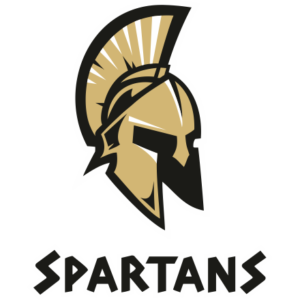
SPARTAN SOCIETY:
Sparta, also known as Lacedaemon, was an ancient Greek city-state located primarily in the present-day region of southern Greece called Laconia. The population of Sparta consisted of three main groups: the Spartans, or Spartiates, who were full citizens the Helots, or serfs/slaves; and the Perioeci, who were neither slaves nor citizens. The Perioeci, whose name means “dwellers-around,” worked as craftsmen and traders, and built weapons for the Spartans.
Did You Know?
The word “spartan” means self-restrained, simple, frugal and austere. The word “laconic”, meaning pithy and concise, is derived from the Spartans, who prized brevity of speech.
All healthy male Spartan citizens participated in the compulsory state-sponsored education system, the Agoge, which emphasized obedience, endurance, courage, and self-control. Spartan men devoted their lives to military service and lived communally well into adulthood. A Spartan was taught that loyalty to the state came before everything else, including one’s family.
The Helots, whose name means “captives,” were fellow Greeks, originally from Laconia and Messenia, who had been conquered by the Spartans and turned into slaves. The Spartan’s way of life would not have been possible without the Helots, who handled all the day-to-day tasks and unskilled labor required to keep society functioning: They were farmers, domestic servants, nurses and military attendants.
Spartans, who were outnumbered by the Helots, often treated them brutally and oppressively in an effort to prevent uprisings. Spartans would humiliate the Helots by doing such things as forcing them to get drunk on wine and then watch them make fools of themselves in public. (This practice was also intended to demonstrate to young people how an adult Spartan should never act, as self-control was a prized trait.) Methods of mistreatment could be far more extreme: Spartans were allowed to kill Helots for being too smart or too fit, among other reasons.
THE SPARTAN MILITARY:
Unlike Greek city-states such as Athens, a center for the arts, learning, and philosophy, Sparta was centered on a warrior culture. Male Spartan citizens were allowed only one occupation: solider. Indoctrination into this lifestyle began early. Spartan boys started their military training at age 7 when they left home and entered the Agoge. The boys lived communally under austere conditions. They were subjected to continual physical, competitions (which could involve violence), given meager rations and expected to become skilled at stealing food, among other survival skills.
The teenage boys who demonstrated the most leadership potential were selected for participation in the Crypteia, which acted as a secret police force whose primary goal was to terrorize the general Helot population and murder those who were troublemakers. At age 20, Spartan males became full-time soldiers, and remained on active duty until age 60.
The Spartans’ constant military drilling and discipline made them skilled at the ancient Greek style of fighting in a phalanx formation. In the phalanx, the army worked as a unit in a close, deep formation, and made coordinated mass maneuvers. No one soldier was considered superior to another. Going into battle, a Spartan soldier, or hoplite, wore a large bronze helmet, breastplate and ankle guards, and carried a round shield made of bronze and wood, a long spear and sword. Spartan warriors were also known for their long hair and red cloaks.
SPARTAN WOMEN AND MARRIAGE:
Spartan women had a reputation for being independent-minded and enjoyed more freedom and power than their counterparts throughout ancient Greece. While they played no role in the military, female Spartans often received a formal education, although separate from boys and not at boarding schools. In part to attract mates, females engaged in athletic competitions, including javelin-throwing and wrestling, and also sang and danced competitively. As adults, Spartan women were allowed to own and manage the property. Additionally, they were typically unencumbered by domestic responsibilities such as cooking, cleaning and making clothing, tasks which were handled by the helots.
Marriage was important to Spartans, as the state put pressure on people to have male children who would grow up to become citizen-warriors and replace those who died in battle. Men who delayed marriage were publically shamed, while those who fathered multiple sons could be rewarded.
In preparation for marriage, Spartan women had their heads shaved; they kept their hair short after they wed. Married couples typically lived apart, as men under the age of 30 were required to continue residing in communal barracks. In order to see their wives during this time, husbands had to sneak away at night.
DECLINE OF THE SPARTANS:
In 371 BCE, Sparta suffered a catastrophic defeat at the hands of the Thebans at the Battle of Lefktra. In a further blow, late the following year, the Theban general Epaminondas (418-362BCE) led an invasion into the Spartan territory and oversaw the liberation of the Messenian Helots, who had been enslaved by the Spartans for several centuries. The Spartans would continue to exist, although as a second-rate power in a long period of decline. In 1834, Otto (1815-67), the king of Greece, ordered the founding of the modern-day town of Spartion at the site of ancient Sparta.
Mystras:
The town of Mystras was founded in the 13th century, after the conquest of Constantinople by the Crusades. The Franks dominated Morea, the area is known today as the Peloponnese and Prince William II Villehardouin built a fortress on the top of the mountain Mystras (alias Mytzithras). In 1259, Villehardouin was captured on the battlefield of Pelagonia by Michael VIII Paleologos, a Byzantine emperor, that set him free in exchange for the castles of Monemvasia and Mystras. The town thus becomes a Byzantine area and gets influenced by the Byzantine architecture and artwork. Since then, Mystras became an important military center and the inhabitants of the neighboring areas started building their homes on the slope of Mystras, seeking security. Although the original area was protected by walls, the increasing number of houses made it necessary to build more walls to enclose new clusters of houses. This fact explains the walls that Mystras hosts until 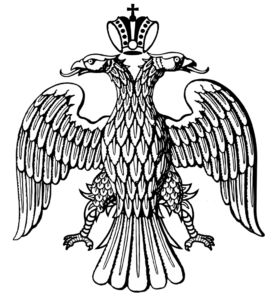 this very day, which constitutes a great attraction for visitors. The first wall was called Chora and the second one Kato Chora. The cathedral of Sparta was also re-established in Mystras. As a result, these movements gave importance to the city that became the capital of Moreas between the mid-14th and mid-15th centuries. Mystras had a permanent lord that ruled for indefinite terms and
this very day, which constitutes a great attraction for visitors. The first wall was called Chora and the second one Kato Chora. The cathedral of Sparta was also re-established in Mystras. As a result, these movements gave importance to the city that became the capital of Moreas between the mid-14th and mid-15th centuries. Mystras had a permanent lord that ruled for indefinite terms and
had the title of Despot. Along time, Mystras became the capital of the famous Despotate of Moreas. From this point on, its history continues with plenty of fights against foreign invaders, including Franks, Slavs, Turks, and Albanians.
The first Despot of Mystras was Emmanuel Kantakouzenos, who ruled from 1348 to 1380. Matthew Kantakouzenos (1380-1383) and Demetrios Kantankouzenos (1383-1384) were the following Despots. Then, Theodor I Paleologos ruled until 1407. During this period, the prosperity of Mystras reached a high level. In fact, the Neoplatonist philosopher George Gemistos Plethon (1355-1452) founded a philosophic school there in 1400. Theodore II ruled from 1407 to 1443. His younger brother, Constantinos Paleologos, ruled Mystras from 1443 to 1449 and then became the last emperor of the Byzantine Empire. After the conquest of Constantinople by the Turks in 1453, his younger brother Demetrius surrendered the castle to them in 1460. Under Turkish occupation, Mystras gradually started to decline. In 1687, the Venetians conquered the area but the Turks gained it back. The inhabitants made many courageous efforts to free their city from the Turks but with no result. In 1825, the Albanian Turks slaughtered the population and destroyed the area, which was later abandoned. Finally, it was set free a few years later and formed part of the first Greek state. In 1831, King Otto founded the new city of Sparta (9 km away) and this resulted in the final decline and abandonment of Mystras. Most families moved to Sparta and others to New Mystras, a small village built in the countryside. In 1952, the remaining properties were expropriated and the city started to be appreciated as one of the most interesting Greek archaeological sites. In 1989, the old town of Mystras was named a UNESCO World Heritage Site.
Nafplio:
The city of Nafplio was the first capital of the modern Greek state. Named after Nafplios, son of Poseidon, and home of Palamidis, their local hero of the Trojan war and supposedly the inventor of weights and measures, lighthouses, the first Greek alphabet and the father of the Sophists. The small city-state made the mistake of allying with Sparta in the second Messenian War (685 – 688 BC) and was destroyed by Damokratis the king of Argos.
Because of the strength of the fort that sits above the bay, the town of Nafplio became an important strategic and commercial center to the Byzantines from around the sixth century AD. In 1203 Leon Sgouros, ruler of the city, conquered Argos and Corinth, and Larissa to the north, though it failed to successfully conquer Athens after a siege in 1204.
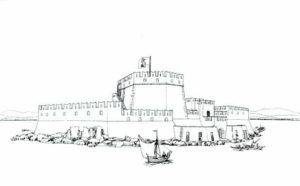 With the fall of Constantinople to the Turks, the Franks, with the help of the Venetians captured the city and nearly destroyed the fortress in the process. In the treaty, the defenders of the city were given the eastern side of the city, called Romeiko and allowed to follow their customs, while the Franks controlled the Akronafplia, which was most of the city at the time. The Franks controlled the city for 200 years and then sold it to the Venetians. The Venetians continued the fortification of the upper town and completed their work in 1470. That same year they built a fort on the small island in the center of the harbor called the Bourtzi. To close the harbor the fort was linked by chains and the town was known as Porto Cadenza, meaning Port of Chains. During this period people flocked to the safety of the fortified city in fear of the Turks and forced the expansion of the city into the lagoon between the sea and the walls of the Akronafplia. The new additions to the city were surrounded with walls and many major buildings were erected including the Church of Saint George. But these new walls didn’t matter because in the treaty with Suleiman the First, Nafplio was handed over to the Turks who controlled the city for 100 years and made it the primary import/export center for mainland Greece.
With the fall of Constantinople to the Turks, the Franks, with the help of the Venetians captured the city and nearly destroyed the fortress in the process. In the treaty, the defenders of the city were given the eastern side of the city, called Romeiko and allowed to follow their customs, while the Franks controlled the Akronafplia, which was most of the city at the time. The Franks controlled the city for 200 years and then sold it to the Venetians. The Venetians continued the fortification of the upper town and completed their work in 1470. That same year they built a fort on the small island in the center of the harbor called the Bourtzi. To close the harbor the fort was linked by chains and the town was known as Porto Cadenza, meaning Port of Chains. During this period people flocked to the safety of the fortified city in fear of the Turks and forced the expansion of the city into the lagoon between the sea and the walls of the Akronafplia. The new additions to the city were surrounded with walls and many major buildings were erected including the Church of Saint George. But these new walls didn’t matter because in the treaty with Suleiman the First, Nafplio was handed over to the Turks who controlled the city for 100 years and made it the primary import/export center for mainland Greece.
In 1686 the Turks surrendered the city to a combined force of Venetians, Germans and Poles, lead by Vice Admiral Morozini and this began the second period of Venetian rule in which massive repairs were made to the fortress and the city including the construction of the fortress in Palamidi. When the Peloponessos falls to the Venetians, Nafplio becomes the capital. But after just thirty years the Turks once again take control of the city, almost totally destroying it, looting it and killing almost all its defenders. Most of the survivors chose to leave and the city while the Turks built mosques, baths, and homes in the eastern style which can still be seen.
In April of 1821 Greek chieftains and Philhellenes surrounded the city of Nafplio and liberated it from the Turks under the leadership of Theodore Kolokotronis. Nafplio became the center of activities that would result in the formation of Modern Greece. In 1823 it becomes the capital of the state which is then recognized by the world powers (England, France and Russia) in 1827.
In January of 1828, Ioannis Kapodistrias is recognized as the first governor and arrives in Nafplion. In 1831 King Otto is chosen as the first King of Greece but a month later Kapodistrias is murdered in the Church of Agios Spiridon.
In 1833 King Otto arrives amid great fanfare to the city of Nafplio where he remains until 1834 when the capital of Greece is moved to Athens.
In 1862 there is a rebellion in Nafplio against the monarchy. A siege by the royal army follows. The rebels are given amnesty in 1862. In 1834 Kolokotronis is jailed in the Palamidi fortress. After the capital moves to Athens, the city of Nafplio becomes of less importance. But it still continues to attract visitors to this very day because its history is virtually the history of modern Greece and because every occupying power has left its mark.
The city of Nafplio is like a living museum. It’s also as lively as any city in Greece.
Mycenae:
Mycenae was a fortified late Bronze Age city located between two hills on the Argolis plain of the Peloponnese, Greece. The acropolis today dates from between the 14th and 13th century BCE when the Mycenaean civilization was at its peak of power, influence and artistic expression.
IN MYTHOLOGY:
In Greek mythology, the city was founded by Perseus, who gave the site its name either after his sword’s scabbard (mykes) fell to the ground and was regarded as a good omen or as he found a 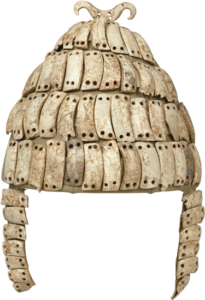 water spring near a mushroom (mykes). Perseus was the first king of the Perseid dynasty which ended with Eurytheus (instigator of Hercules’ famous twelve labors). The succeeding dynasty was the Atreids, whose first king, Atreus, is traditionally believed to have reigned around 1250 BCE. Atreus’ son Agamemnon is believed to have been not only king of Mycenae but of all of the Achaean Greeks and the leader of their expedition to Troy to recapture Helen. In Homer’s account of the Trojan War in the Iliad, Mycenae (or Mykene) is described as a ‘well-founded citadel’, as ‘wide-wayed’ and as ‘golden Mycenae’, the latter supported by the recovery of over 15 kilograms of gold objects recovered from the shaft graves in the acropolis.
water spring near a mushroom (mykes). Perseus was the first king of the Perseid dynasty which ended with Eurytheus (instigator of Hercules’ famous twelve labors). The succeeding dynasty was the Atreids, whose first king, Atreus, is traditionally believed to have reigned around 1250 BCE. Atreus’ son Agamemnon is believed to have been not only king of Mycenae but of all of the Achaean Greeks and the leader of their expedition to Troy to recapture Helen. In Homer’s account of the Trojan War in the Iliad, Mycenae (or Mykene) is described as a ‘well-founded citadel’, as ‘wide-wayed’ and as ‘golden Mycenae’, the latter supported by the recovery of over 15 kilograms of gold objects recovered from the shaft graves in the acropolis.
HISTORICAL OVERVIEW:
Situated on a rocky hill (40-50 m high) commanding the surrounding plain as far as the sea 15 km away, the site of Mycenae covered 30,000 square meters and has always been known throughout history. First excavations were begun by the Archaeological Society of Athens in 1841 and then continued by the famous Heinrich Schliemann in 1876 that discovered the magnificent treasures of Grave Circle A. The archaeological excavations have shown that the city has a much older history than traditional Greek literature described.
Even though the site was inhabited since Neolithic times, it is not until 2100 BCE that the first walls, pottery finds (including imports from the Cycladic islands) and pit and shaft graves with higher quality grave goods appear. These, collectively, suggest greater importance and prosperity in the settlement.
Since 1600 BCE there is evidence of an elite presence on the acropolis: high-quality pottery, wall paintings, shaft graves and an increase in the surrounding settlement with the construction of large  tholos tombs. From the 14th century BCE the first large-scale palace complex is built (on three artificial terraces), so is the celebrated tholos tomb, the Treasury of Atreus, a monumental circular building with corbelled roof reaching a height of 13.5 m and 14.6 m in diameter and approached by a long walled and unroofed corridor 36 m long and 6m wide. Fortification walls, of large roughly worked stone blocks, surrounding the acropolis (of which the north wall is still visible today), flood management structures such as dams, roads, Linear B tablets and an increase in pottery imports (fitting well with theories of contemporary Mycenaean expansion in the Aegean) illustrate the culture was at its zenith.
tholos tombs. From the 14th century BCE the first large-scale palace complex is built (on three artificial terraces), so is the celebrated tholos tomb, the Treasury of Atreus, a monumental circular building with corbelled roof reaching a height of 13.5 m and 14.6 m in diameter and approached by a long walled and unroofed corridor 36 m long and 6m wide. Fortification walls, of large roughly worked stone blocks, surrounding the acropolis (of which the north wall is still visible today), flood management structures such as dams, roads, Linear B tablets and an increase in pottery imports (fitting well with theories of contemporary Mycenaean expansion in the Aegean) illustrate the culture was at its zenith.
ARCHITECTURE:
The large palace structure built around a central hall or Megaron is typical of Mycenaean palaces. Other features included a secondary hall, many private rooms, and a workshop complex. Decorated stonework and frescoes and a monumental entrance, the Lion Gate (a 3 m x 3 m square doorway with an 18-ton lintel topped by two 3 m high heraldic lions and a column altar), added to the overall splendor of the complex. The relationship between the palace and the surrounding settlement and between Mycenae and other towns in the Peloponnese is much discussed by scholars. Concrete archaeological evidence is lacking but it seems likely that the palace was a center of political, religious and commercial power. Certainly, high-value grave goods, administrative tablets, pottery imports and the presence of precious materials deposits such as bronze, gold, and ivory would suggest that the palace was, at the very least, the hub of a thriving trade network.
The first palace was destroyed in the late 13th century, probably by the earthquake and then (rather poorly) repaired. A monumental staircase, the North Gate, and a ramp were added to the acropolis and the walls were extended to include the Perseia spring within the fortifications. The spring was named after the city’s mythological founder and was reached by an impressive corbelled tunnel (or syrinx) with 86 steps leading down 18m to the water source. It is argued by some scholars that these architectural additions are evidence for a preoccupation with security and possible invasion. This second palace was also destroyed, this time with signs of fire. Some rebuilding did occur and pottery finds suggest a degree of prosperity returned briefly before another fire ended the occupation of the site until a brief revival in Hellenistic times. With the decline of Mycenae, Argos became the dominant power in the region. Reasons for the demise of Mycenae and the Mycenaean civilization are much debated with suggestions including natural disasters, over-population, internal social and political unrest or invasion from foreign tribes.
Epidaurus:
Located on the fertile Argolid plain of the east Peloponnese in Greece and blessed with a mild climate and natural springs, the sanctuary of Asclepius at Epidaurus was an important sacred center in both ancient Greek and Roman times.
Epidaurus was named after the hero Epidauros, son of Apollo. Inhabited since Neolithic times, the first significant settlement was in the Mycenaean period. Fortifications, a theatre and tholos tombs have been excavated dating as early as the 15th century BCE, although it was in the 12th century BCE that Epidaurus Limera, with its harbor linking it to the Aegean trade network, particularly flourished.
Earlier regional worship of the deity Maleatas evolved into the later worship of Apollo, who was given similar attributes. However, it was Asclepius (also spelt Asklepios), whom the Epidaurians believed was born on the nearby Mt. Titthion, who took precedence from the 5th century BCE until Roman times in the 4th century CE. Credited with possessing great healing powers (learned from his father Apollo) and also those of prophecy, the god – as manifested in the sanctuary or Asklepieion – was visited from all over Greece by those seeking ease and remedies from their illnesses either by divine intervention or medicines administered by the priests. The sanctuary used the wealth gained from dedications of the worshipers to build an impressive complex of buildings and to sponsor major art projects to beautify the center. Indeed, many of the offerings given were works of art such as statues, pottery vessels, tripods, and even buildings.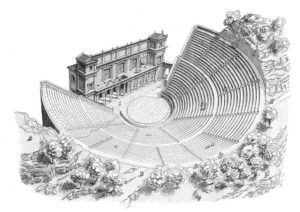
At the height of the site’s importance in the 4th century BCE (370 – 250 BCE), major buildings included two monumental entrances (Propylaia); a large temple (380 – 375 BCE) with the typical 6×11 column Doric layout, containing a larger than life-size Chryselephantine statue of a seated Asclepius (by Thrasymedes) and with pediments displaying in statuary the Amazonomachy and the Siege of Troy; temples dedicated to Aphrodite (320 BCE), Artemis and Themis; a sacred fountain; the Thymele (360-330 BCE) – around marble building originally with 26 outer Doric columns, a 14 Corinthian columned cella and a mysterious underground labyrinth, perhaps containing snakes which were associated with Asclepius; the columned Abato (or Enkoimeterion) in which patients waited overnight for divine intervention and remedy; other temples, hot and cold bathhouses, stoas, stadium, palaistra and large gymnasia; and a 6000 seat theatre (340 – 330 BCE). These latter sporting and artistic buildings were used in the Asklepieia festival, founded in the 5th century BCE and held every four years to celebrate theatre, sport, and music. The theatre, with 2nd century CE additions resulting in 55 tiers of seats and a capacity of perhaps 12,300 spectators, would become one of, if not the, largest theatres in antiquity. Other Roman additions to the site in the 2nd century included a temple of Hygieia, a large bath building and a small odeum.
The site was destroyed in 395 CE by the Goths and the Emperor Theodosius II definitively closed the site along with all other pagan sanctuaries in 426 CE. The site was abandoned once and for all following earthquakes in 522 and 551 CE. Excavations at the ancient site were first begun in 1881 CE by the Greek Archaeological Society and continue to the present day. Today, the magnificent theatre, renowned for its acoustics, is still in active use for performances in an annual traditional theatre festival.
Ancient Corinth:
Located on the isthmus which connects mainland Greece with the Peloponnese, surrounded by fertile plains and blessed with natural springs, Corinth was an important city in Greek, Hellenistic, and Roman times. Its geographical location, role as a center of trade, naval fleet, participation in various Greek wars, and status as a major Roman colony meant the city was, for over a millennium, rarely out of the limelight in the ancient world.
CORINTH IN MYTHOLOGY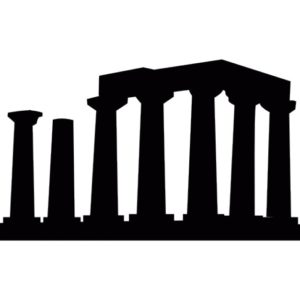
Not being a major Mycenaean center, Corinth lacks the mythological heritage of other Greek city-states. Nevertheless, the mythical founder of the city was believed to have been King Sisyphus, famed for his punishment in Hades where he was made to forever roll a large boulder up a hill. Sisyphus was succeeded by his son Glaucus and his grandson Bellerophon, whose winged-horse Pegasus became a symbol of the city and a feature of Corinthian coins. Corinth is also the setting for several other episodes from Greek mythology such as Theseus’ hunt for the wild boar, Jason settled there with Medea after his adventures looking for the Golden Fleece, and there is the myth of Arion – the real-life and gifted kithara player and resident of Corinth – who was rescued by dolphins after being abducted by pirates.
HISTORICAL OVERVIEW
The city was first inhabited in the Neolithic period (c. 5000 BCE), but became more densely populated from the 10th century BCE. The historical founders were the aristocratic descendants of King Bacchis, the Bacchiadae (c. 750 BCE). The Bacchiadae ruled as a body of 200 until in 657 BCE when the popular tyrant Cypselus took control of the city, to be succeeded by his son Periander (627-587 BCE). Cypselus funded the building of a treasury at Delphi and set up new colonies.
From the 8th century BCE, Corinthian pottery was exported across Greece. With its innovative figure decoration, it dominated the Greek pottery market until the 6th century BCE when Attic black-figure pottery took over as the dominant style. Other significant exports were Corinthian stone and bronze wares. Corinth also became the hub of trade through the dilokos. This was a stone track with carved grooves for wheeled wagons which offered a land short-cut between the two seas and probably dates to the reign of Periander. In the Peloponnesian War, the diolkos was even used to transport triremes. Although the idea for a canal across the isthmus was first considered in the 7th century BCE and various Roman Emperors from Julius Caesar to Hadrian began surveys, it was Nero who actually began the project (67 CE). However, on the emperor’s death, the project was abandoned, not to be resumed until 1881.
From the early 6th century BCE, Corinth administered the PanHellenic games at nearby Isthmia, held every two years in the spring. These games were established in honor of Poseidon and were particularly famous for their horse and chariot races.
An oligarchy, consisting of a council of 80, gained power in Corinth (585 BCE). Concerned with the local rival, Argos, from 550 BCE Corinth became an ally of Sparta. During Cleomenes’ reign though, the city became wary of the growing power of Sparta and opposed Spartan intervention in Athens. Corinth also fought in the Persian Wars against the invading forces of Xerxes which threatened the autonomy of all of Greece.
Corinth suffered badly in the First Peloponnesian War, which it was responsible for after attacking Megara. Later it was also guilty of causing the Second Peloponnesian War, in 433 BCE. Once again though, the Corinthians, mainly as Sparta’s naval ally, had a disastrous war. Disillusioned with Sparta and concerned over Spartan expansion in Greece and Asia Minor, Corinth formed an alliance with Argos, Boeotia, Thebes, and Athens to fight Sparta in the Corinthian Wars (395-386 BCE). The conflict was largely fought at sea and on Corinthian territory and was yet another costly endeavor for the citizens of Corinth.
 Corinth became the seat of the Corinthian League, but losing a war against Philip II of Macedon (338 BCE) this ‘honor’ was a Macedonian garrison being stationed on the Acrocorinth acropolis overlooking the city.
Corinth became the seat of the Corinthian League, but losing a war against Philip II of Macedon (338 BCE) this ‘honor’ was a Macedonian garrison being stationed on the Acrocorinth acropolis overlooking the city.
A succession of Hellenistic kings took control of the city – starting with Ptolemy I and ending with Aratus in 243 BCE when Corinth joined the Achaean League. However, the worst was yet to come, when the Roman commander Lucius Mummius sacked the city (146 BCE).
A brighter period was when Julius Caesar took charge (in 44 BCE) and organized the agricultural land into organized plots (centurion) for distribution to Roman settlers. The city once more flourished, by the 1st century CE it became an important administrative and trade center again. In addition, following St. Paul’s visit between 51 and 52 CE, Corinth became the center of early Christianity in Greece. In a public hearing, the saint had to defend himself against accusations from the city’s Hebrews that his preaching undermined the Mosiac Law. The pro-consul Lucius Julius Gallio judged that Paul had not broken any Roman law and so was permitted to continue his teachings. From the 3rd century, CE Corinth began to decline and the Germanic tribes attacked the city.
THE ARCHAEOLOGICAL SITE
In Greek Corinth, there were cults to Aphrodite (protector of the city), Apollo, Demeter Thesmophoros, Hera, Poseidon, and Helios and various buildings to cult heroes, the founders of the city. In addition, there were several sacred springs, the most famous being Peirene. Unfortunately, the destruction in 146 BCE erased much of this religious past. In Roman Corinth, Aphrodite, Poseidon, and Demeter did continue to be worshipped along with the Roman gods.
The site today, first excavated in 1892 CE by the Greek Archaeological Service, is dominated by the Doric peripteral Temple of Apollo (550-530 BCE), originally with 6 columns on the façades and fifteen on the long sides. A particular feature of the temple is the use of monolithic columns rather than the more commonly used column drums. Seven columns remain standing today.
The majority of the other surviving buildings date from the 1st century CE in the Roman era and include a large forum, a temple to Octavia, baths, the Bema where St. Paul addressed the Corinthians, the Asklepeion temple to Asclepius, and a center of healing, fountains – including the monumental Peirine fountain complex (2nd century CE) – a propylaea, theatre, Odeon, gymnasium, and stoas. There are also the remains of three basilicas.
Archaeological finds at the site include many fine mosaics – notably the Dionysos mosaic – Greek and Roman sculpture – including an impressive number of busts of Roman rulers.
Acrocorinth:
The steep rock of the Acrocorinth rises to the south-west of the ancient Corinth, surmounted by the fortress, also called the Acrocorinth, which was the fortified citadel of ancient and medieval Corinth and the most important fortification work in the area from antiquity until the Greek War of Independence in 1821. It is 575 m. high and its walls are a total of almost 2.000 m. in length.
The ascent to Acrocorinth – Acrocorinthos, is facilitated by a road which climbs to a point near the lowest gate on the W side. This commanding site was fortified in ancient times and its defenses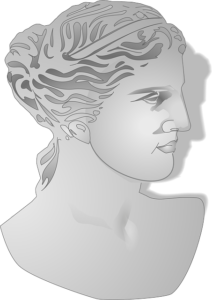 were maintained and developed during the Byzantine, Frankish, Turkish and Venetian periods. After a moat (alt. 380 m -1247 feet) constructed by the Venetians follow the first gate, built in the Frankish period (14th,c.) and the first wall 15th c. then come the second and third walls (Byzantine: on the right, in front of the third gate, a Hellenistic tower). Within the fortress we follow a path running NE to the remains of a mosque (16th c.) and then turn S until we join a path leading up to the eastern summit, on which there once stood the famous Temple of Aphrodite, worshipped here after the Eastern fashion (views of the hills of the Peloponnese and of Isthmus).
were maintained and developed during the Byzantine, Frankish, Turkish and Venetian periods. After a moat (alt. 380 m -1247 feet) constructed by the Venetians follow the first gate, built in the Frankish period (14th,c.) and the first wall 15th c. then come the second and third walls (Byzantine: on the right, in front of the third gate, a Hellenistic tower). Within the fortress we follow a path running NE to the remains of a mosque (16th c.) and then turn S until we join a path leading up to the eastern summit, on which there once stood the famous Temple of Aphrodite, worshipped here after the Eastern fashion (views of the hills of the Peloponnese and of Isthmus).
Courses of roughly dressed polygonal masonry allow us to suppose that the Acrocorinth was fortified as early as the time of the Kypselid tyranny (late 7th c. early 6th c. BC). The surviving parts of the ancient fortifications, however, which are at many points beneath the medieval enceinte, belong mainly to the 4th c. BC. In 146 BC, Mummius destroyed the fortifications of the lower city and the acropolis. The destroyed sections were subsequently reconstructed from the s During the Middle Ages, the Acrocorinth was of prime importance for the defense of the entire Peloponnese, and held out against the attacks of the barbarians. The Byzantines sporadically repaired the walls, especially after hostile raids (by the Slavs, Normans, and others), and added new fortifications on the west side of the fortress. In 1210, after a five-year siege, the Acrocorinth was captured by Otto de la Roche and Geoffroy I Villehardouin, and was incorporated in the Frankish principate of Achaea. In the middle of this century, William Villehardouin extended the fortifications of the fortress, to be followed in this by the Angevin Prince John Gravina at the beginning of the 14th c.ame ancient material in Late Roman times.
In 1358 the Acrocorinth passed to the Florentine banker Niccolo Acciajuoli, and in 1394 to Theodoros I Palaiologos despot of Mystras. Apart from a brief occupation by the Knights of Rhodes from 1400-1404, the fortress remained in Byzantine hands until 1458, when it was captured by the Ottoman Turks. The Venetians made themselves masters of the Acrocorinth from 1687 to 1715, after which it reverted once more to the Turks until the Greek Uprising of 1821. The approach to the fortress is from the west side. The walls have an irregular shape, which was dictated by the form of the terrain and remained the same in general terms from the Classical period to modern times. Three successive zones of fortifications, with three imposing gateways, lead to the interior of the fortress. The fact that the same material was used for extensions or repairs to the walls frequently makes it difficult to distinguish the building phases or assign a date to them.
Cancellation Policy

All cancellations must be confirmed by Olive Sea Travel.
- Regarding the Multiple Day Tours:Cancellations up to 30 Days before your service date are 100% refundable.
Cancellation Policy:
-
- Licensed Tour Guides and Hotels are external co-operators & they have their own cancellation policy.
- Apart from the above cancellation limits, NO refunds will be made. If though, you fail to make your appointment for reasons that are out of your hands, that would be, in connection with the operation of your airline or cruise ship or strikes, extreme weather conditions or mechanical failure, you will be refunded 100% of the paid amount.
- If your cancellation date is over TWO (2) months away from your reservation date, It has been known for third-party providers such as credit card companies, PayPal, etc. to charge a levy fee usually somewhere between 2-4%.
- Olive Sea Travel reserves the right to cancel your booking at any time, when reasons beyond our control arise, such as strikes, prevailing weather conditions, mechanical failures, etc. occur. In this unfortunate case, you shall be immediately notified via the email address you used when making your reservation and your payment WILL be refunded 100%.
Recommended for you

Athens Full Day Private Tour


